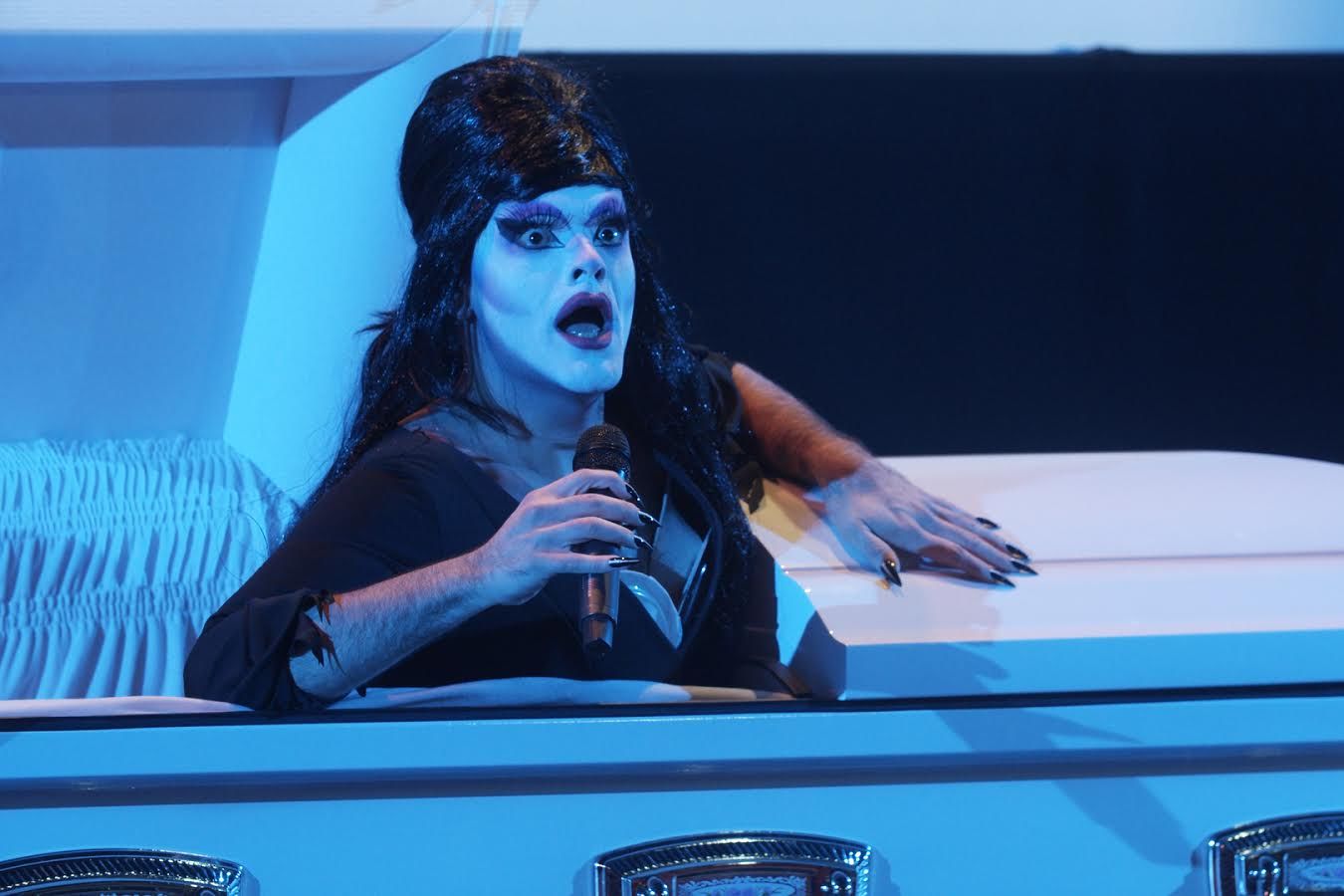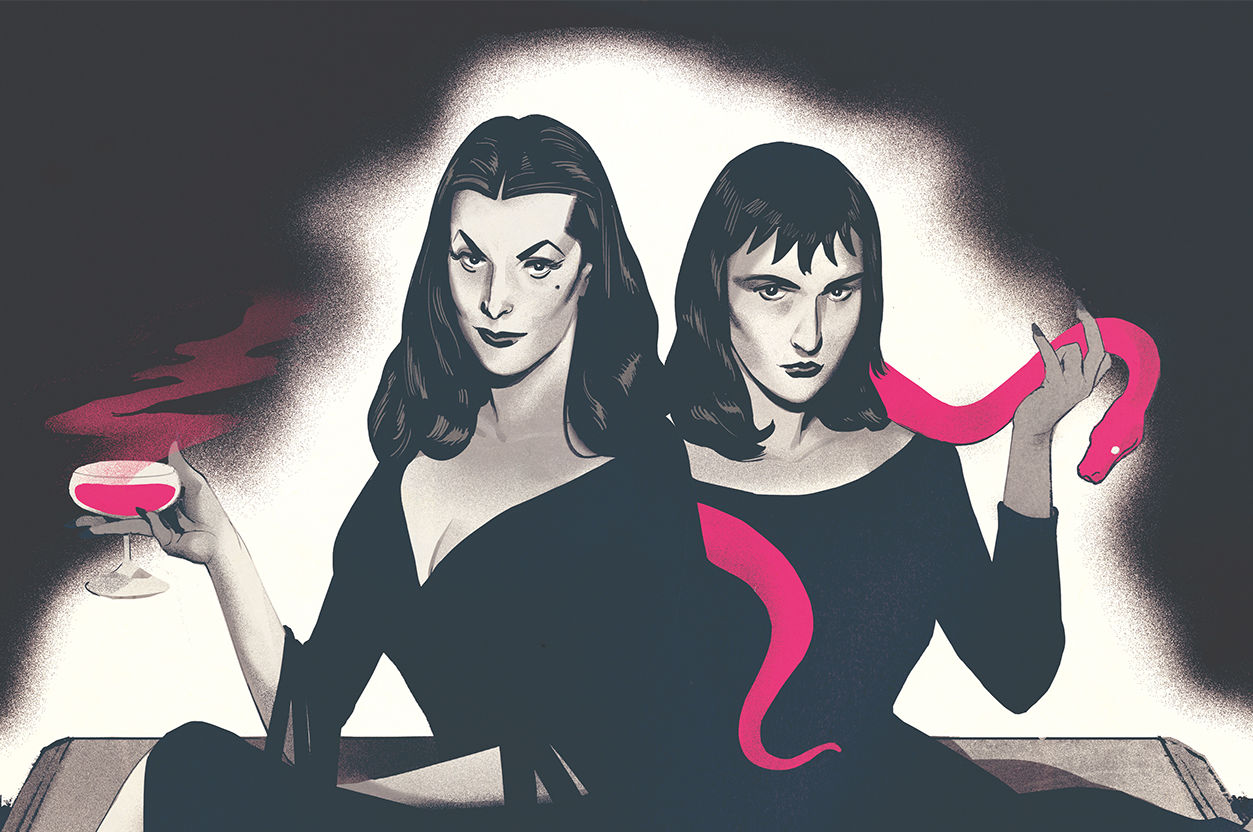
Remembering Vampira and Tarantula Ghoul, Oregon’s Scream Queens
In 1988, on the salacious public access show Skip E. Lowe Looks at Hollywood, a woman wearing spiderweb glasses on her face and a doily in her hair outlined how she first met James Dean. “I had gone to a premiere, it was a premiere of Roman Holiday,” she began, baring her crooked teeth and hitting her “pre”s with a transatlantic punch. “And I wanted to see who makes up the glittering people of that Hollywood firmament.”
Twenty years later, the same woman passed away quietly on a couch in her North Hollywood apartment, next to an also-dead cat, with her feet resting on a lawn chair. She was subsequently cremated and laid to rest at the Hollywood Forever Cemetery off of Santa Monica Boulevard. In enormous type, next to a cartoon rendering of her willowy figure draped in black silk, her headstone read, “VAMPIRA: Hollywood Legend.” To this day, cemetery attendants spend their mornings wiping it clean of red and black lipstick stains.
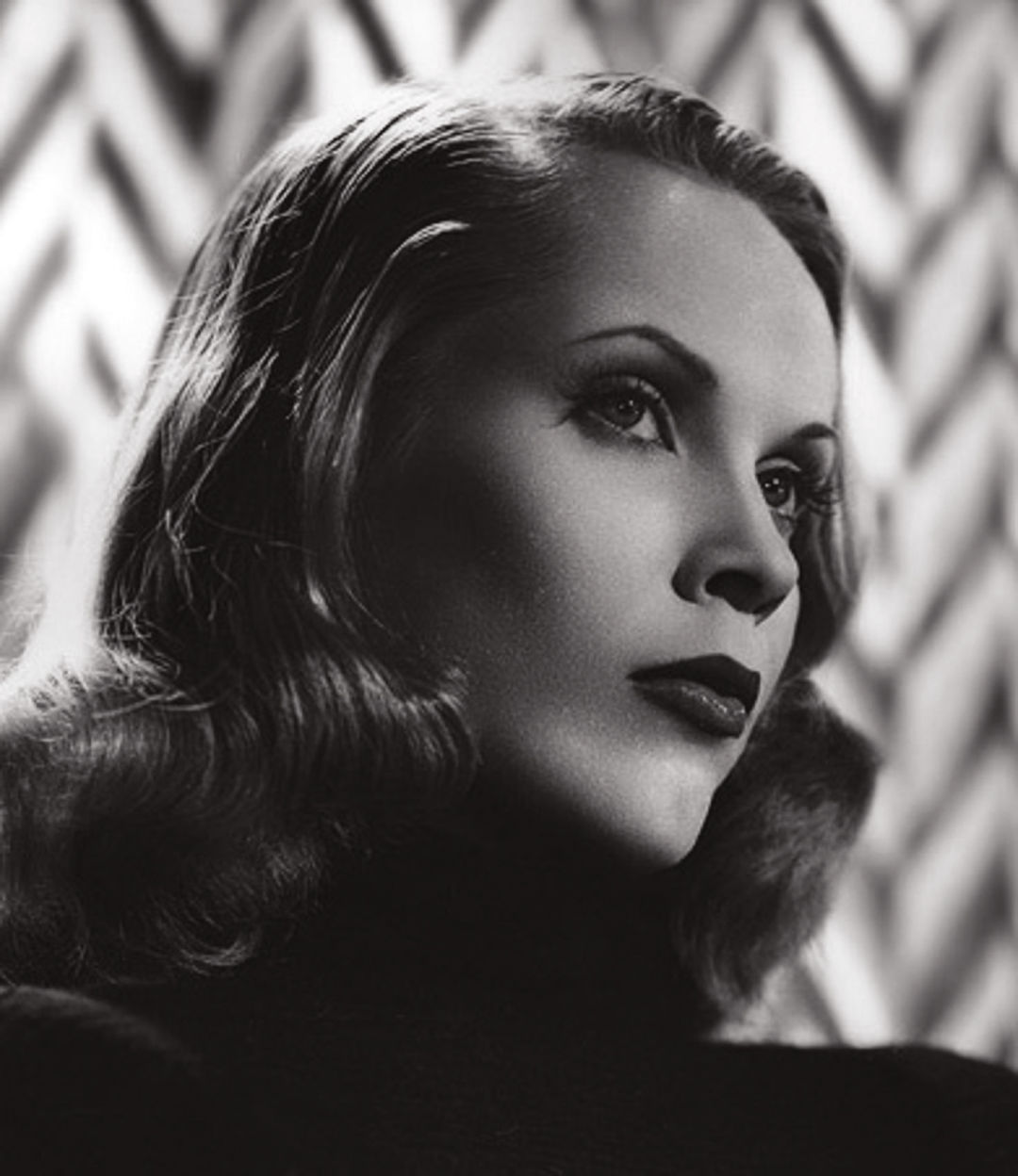
A pre-Vampira Maila Nurmi
Maila Niemi was born in 1922, in Gloucester, Massachusetts—though rumors persisted well into the 21st century (at her own urging) that she was actually born on a Finnish panhandle eventually seized by the Soviets. After some jostling, she landed in Astoria in 1939, where she finished high school and entered adulthood as a strawberry picker and tuna canner for the Columbia River Packers Association.
It didn’t take much picking or packing for Niemi to grow restless. Still living at home in her late teens, she caught an Orson Welles radio broadcast from the bathtub one evening and told her mother she would befriend him someday. “Don’t talk like that. People will say you’re crazy,” the elder Niemi replied, according to Maila’s niece, Sandra, in her extensively researched 2021 biography Glamour Ghoul. “You are Maila Elizabeth Niemi, and you work in a fish cannery in Oregon. And don’t you forget it.”
The following year, Niemi forgot it in spectacular fashion. She caught a bus from Oregon to Los Angeles, changed her last name to Nurmi, and kicked off a long, circuitous acting career that spanned coasts and mediums. Over the course of a decade and a half, Nurmi racked up numerous credits on stage and screen, became a model, pissed off Mae West so bad it lost her a Broadway role, had a child with—yes—Orson Welles (while he was still married to Rita Hayworth), and joined that rarified club known as “people who had an affair with Marlon Brando.” She made friends, enemies, and a name for herself in the sorts of brazen melodramatic strokes that smack of conscious self-mythology. And then, in 1954, at the age of 32, Nurmi cemented a place in the same glittering Hollywood firmament that fascinated her: she became Vampira, the world’s first horror host.
For just under a year on KABC-TV in LA, Nurmi portrayed a long-nailed, Morticia Addams–inspired “glamour ghoul” who introduced flimsy B movies with spectacularly campy, pre-taped segments that aired in the dead of night. Each episode of The Vampira Show began the same way: To the tune of a gently discordant theme, Nurmi’s silhouette would appear at the end of a smoke-choked, German Expressionist hallway. Then, in a fringe-draped black gown, she’d saunter toward the camera, swaying her impossibly small waist back and forth, lips pursed. After a brief pause, she’d open her mouth and let out a shriek Janet Leigh would no doubt study under Hitchcock a few years later, cartoon eyebrows vaulting to the sky.
A serene look would set in. She’d sigh and toss her hair. “Ah,” she’d admit, eyes clamped shut in ecstasy. “Screaming relaxes me so.” In isolation, it reads like a classic, sexed-up slice of gallows humor. Given the context of the rest of Nurmi’s life, it lands more like determined self-soothing.
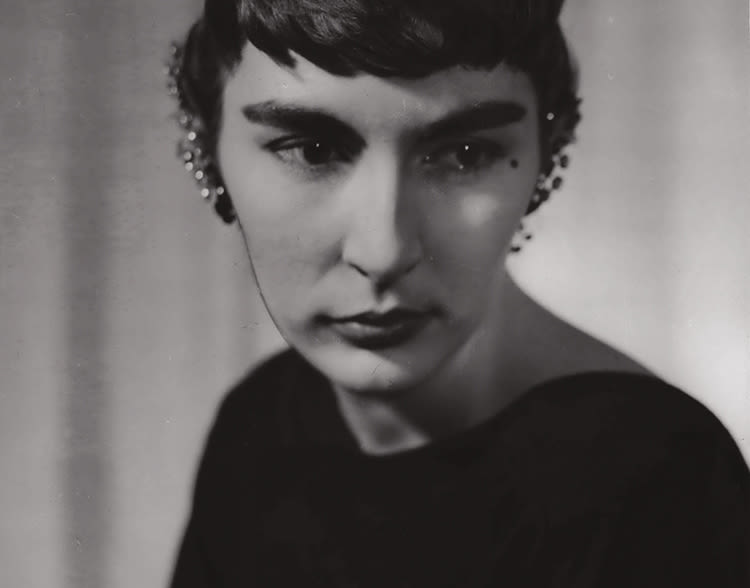
Suzanne Waldron
Image: courtesy TV radio mirror
Concurrent with Vampira’s rise, another Oregon girl was walking a (admittedly more modest) path to kitschy TV stardom. In the early 1950s, Portlander Suzanne Waldron started studying the performing arts under the dusty skies of Las Vegas, New Mexico. After a truncated stint in the Southwest gave way to a theater degree from Lewis & Clark, Waldron caught the eye of local NBC affiliate KPTV while playing a witch in Macbeth at Portland Civic Theatre.
This was 1957. The Vampira Show, while wildly successful, had been canceled in LA two years earlier, when Nurmi declined to sign the rights of her character over to ABC. Like other local stations were scrambling to do, the folks at KPTV were unsubtly setting out to build their own Vampira for the Pacific Northwest, complete with the kinds of publicity stunts that had catapulted Nurmi to fame well outside of Los Angeles.
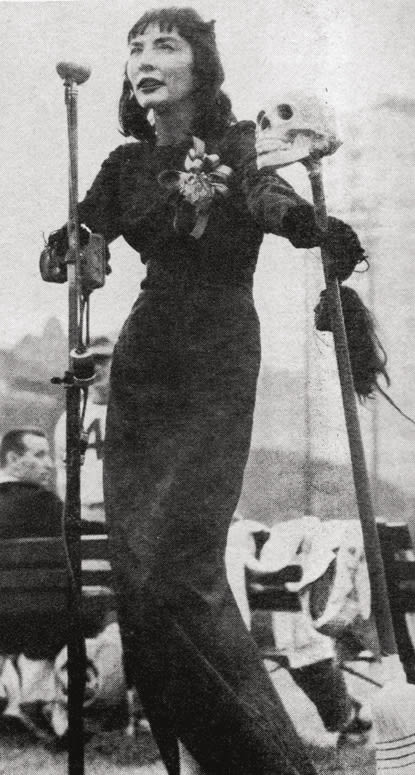
Tarantula Ghoul with some of her trademark props
Image: courtesy TV radio mirror
Thus, fledgling regional stage star Suzanne Waldron was reborn as Tarantula Ghoul, another Morticia Addams lookalike who slung zingers about movies like The Thing well past prime time, accompanied by a puppet spider named Sir Galahad and real boa constrictor named Baby. An early Oregonian ad for Waldron’s show, House of Horror, sets the tone pretty effectively: “We Dare You to Watch ‘HOUSE OF HORROR’,” it shouts above a shaggy illustration of Tarantula, waving a Cruella de Vil cigarette in elbow-length black gloves with a big-eyed spider on her shoulder. “P.S. Not recommended for children, sissies or the weak hearted. (Chicken if you don’t watch.)” The brave took note, and House of Horror became a particular hit with young people, postscript be damned. After the first episode, several wrote in to express their distress about a gag where Tarantula passes a grave marked “Lassie.” “You wouldn’t think kids would be up that late,” Waldron replied.
While she lacked access to any Marlon Brandos or Orson Welleses to involve herself with for the benefit of a gossip-hungry public, Waldron took a page from stunts like Vampira’s campaign for “Night Mayor of Hollywood” and leaned into the high camp of her persona. Shortly after House of Horror started airing, Tarantula appeared at a double feature of The Black Scorpion and The Monster from Green Hell at Gresham’s Mt Hood Theatre to sign death certificates in the lobby. During a late-’50s Ducks vs. Beavers football game in Corvallis, she was scheduled to perform at halftime after emerging from her signature coffin; when it came time for her pallbearers to open the lid, she’d fallen asleep.
Waldron frequently showed up in B. Mike’s dishy “Behind the Mike” society column in the Oregonian, sometimes as a barometer for spookiness and other times as the center of prop-based shenanigans. (An October 1957 edition lays out the farcical misplacement of her coffin during a scheduled appearance at an Oregon Ad Club luncheon.) It was in that column, in December 1958, that Mike announced the end of Tarantula Ghoul’s local TV reign. Despite significant popularity with the public and a minor musical hit with her 1958 novelty single “Graveyard Rock,” by the time Tarantula Ghoul’s House of Horror called it quits it had lasted just two months longer than The Vampira Show had. “Sad news for horror fans,” the announcement began. “Tarantula Ghoul presents her last show over at KPTV tonight. Tarantula (Suzanne Waldron) will leave for rehearsals of New York show Jan. 1. You may be able to catch a brief glimpse of her on KPTV’s Christmas Eve program....”
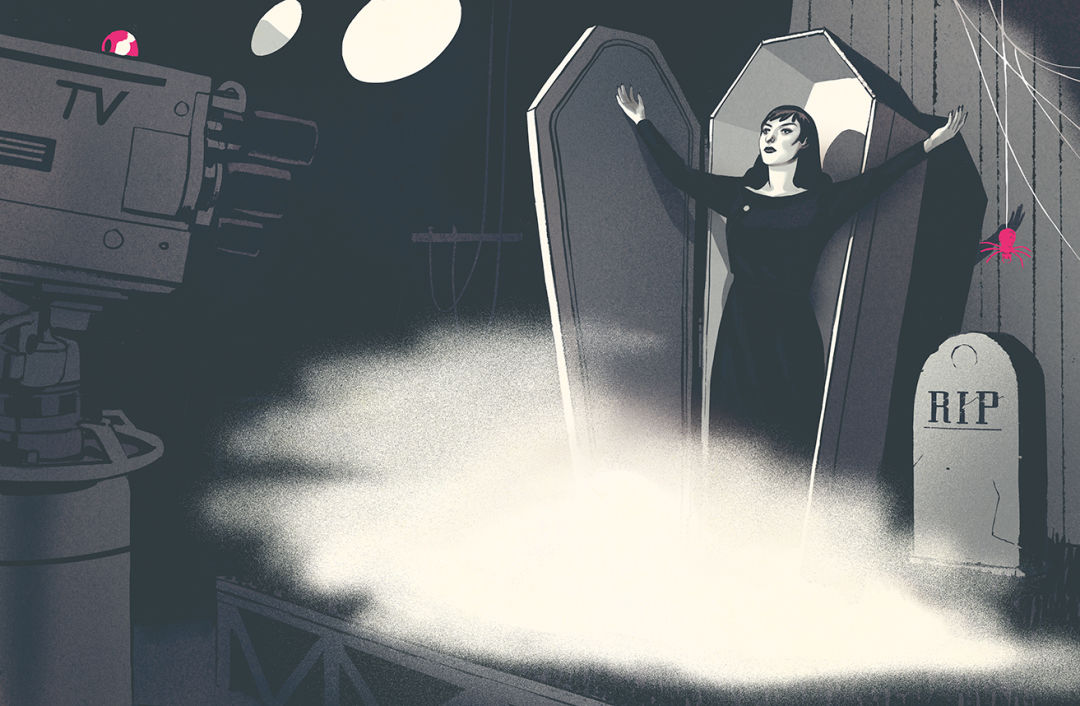
Image: Patrick Leger
Contrary to any alleged Big Apple conflicts, the rumor mill offered a different explanation for Waldron’s sudden departure: she was pregnant out of wedlock, and the studio didn’t want to risk the bad publicity. Her son Michael, now in his 60s, confirms as much. Waldron had begun an affair with KPTV employee John Petty, who was married, during House of Horror’s run, and wound up pregnant with her first child as a result. “Back then, that was not a good thing,” as Michael puts it. Waldron fled to Seattle when she started to show in early 1959, then to Washington, DC, to have the baby—Michael’s older brother, John. Michael was born the following year.
John Petty divorced his wife and married Waldron in 1960 at a ceremony in Stevenson, Washington. Tarantula Ghoul never appeared on TV again. Petty went on to become KPTV’s general sales manager.
F
or a certain type of person—often queer, often enthralled by the vibes of peak-period Tim Burton—horror hosts like Vampira and Tarantula Ghoul (see below for more) occupy the same “outsider hero” position as, say, David Bowie, except dipped in embalming fluid and covered with spiders. They’re drag queens for the Halloween set, larger-than-life purveyors of gothy camp whose DNA can be traced to more than one subsequent cat-eyed gay icon.
Anthony Hudson, who performs as drag clown Carla Rossi and hosts the Hollywood Theatre’s Queer Horror series, has modeled a significant amount of their career on Vampira, Tarantula, and their ilk. “For me, growing up gay and Native and queer and the million other things I identify as, there’s that sense of not feeling like you belong. Once you see something horrific or fantastic or macabre or ghoulish, you realize there’s another reality you can escape to,” they say. “And after a while, if you’re just the right combination of weirdo and attention-starved creative kid, you kind of harness that reality and figure out how to make it your own, which all these people did.”
Before a 2019 Queer Horror screening of Elvira: Mistress of the Dark (more on her later), Hudson closed the gap between the horror hosts of yesterday and the drag queens of today. In a preshow performance called “The Real Queens of Halloween,” Portland performers Wanda Bones, Rummy Rose, and Hai Fleisch accompany Rossi to play Elvira, Vampira, and Tarantula Ghoul. The four women battle for the title of Portland’s Queen of Halloween, lip-syncing and bickering like Drag Race contestants crossed with Bravo Housewives. (The skit was taped and posted on Hudson’s website as the first episode of their web series Tales from Queer Horror.)
In the case of both Vampira and Tarantula Ghoul, this queer cultural infatuation is more than just some posthumous rewrite. Both spent their lives convening with (often-gay) outsiders, and both gained devotion the same way plenty of party girls had before and have since, from Judy Garland to Courtney Love. For fear of being hit on at traditional bars before she met her husband—the perils of local celebrity—Waldron frequented Portland’s underground gay social scene in the ’50s, where she made a group of friends she kept for her entire life. Michael Petty recalls returning home from Meadow Park Middle School one afternoon in the early ’70s to find his house strewn with sleeping, hungover gay men. “She’d gone to the bar the night before and brought all these people home for an after-party,” Petty says. “You couldn’t stop her sometimes. She loved to talk.”
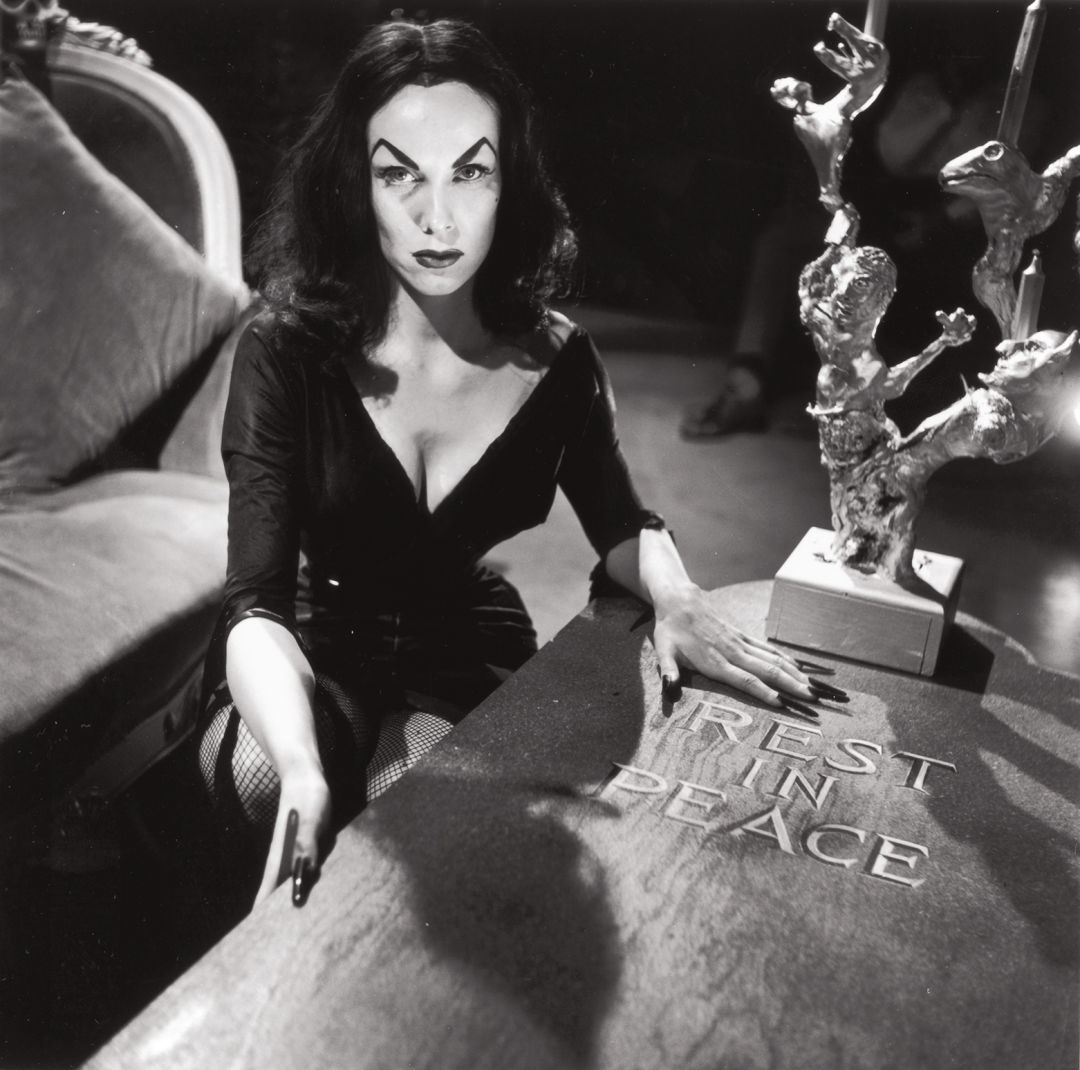
Vampira on set
Even after Nurmi broke into the world of Hollywood insiders, her spot was tenuous, and she gathered most of her notoriety in the shadows. She became close with James Dean around the time The Vampira Show was taking off, while the young actor was filming Rebel Without a Cause. When he died the following year, the tabloids had a heyday with the connection, implying (sometimes outright stating) that Nurmi was both Dean’s spurned former lover and a practicing witch whose black magic brought about his untimely demise. “JAMES DEAN’S BLACK MADONNA,” read one headline, in Whisper magazine, followed by a story insisting that Nurmi had cursed photos of Dean, which caused him to lose control of his car.
Then there’s Jack Simmons. A sometime-friend of Nurmi’s—in one interview, she simply refers to him as her driver—Simmons was both a costar of Dean’s in Rebel and, according to Nurmi, a groupie (we might say “deranged stan” now) of the highest order. In a late-in-life interview with punk publication Please Kill Me, Nurmi lays out Simmons’s alleged unsuccessful pursuits of Dean, which seem to delight and disgust her in equal measure. Then she drops one macabre-ass bombshell: right after Dean died, she says, Simmons told her he was going to tear open his coffin and “get what he never got.”
“That was pretty sick hearing that,” she admits, at this point well into her 80s. “The funeral took place in Indiana. Jack flew out there.... It was a small town and everybody knew everybody else. But they said the night before the burial, the funeral parlor was broken into and his coffin was in disarray and the body was not in its proper condition. Unbelievable.”
A year after Dean died, Simmons and Nurmi attended a Halloween party together in Hollywood. Nurmi went as a witch, and Simmons went as a bandaged-up Dean.
“It’s one of the gayest, most morbid, and scandalous things alleged to have happened in Hollywood that no one is talking about,” says Matty Newton, a Portland illustrator and veritable font of Old Hollywood knowledge. “I’d produce a movie about it if I had the dollars. Somehow Ryan Murphy is going to read this and it will be on Netflix within two years.”
L
ike a lot of lurid celebrity implosions, the downfalls of Vampira and Tarantula Ghoul straddle the line between salacious and sad. (Ryan Murphy has entered the chat.) After Nurmi declined to give up the rights to her creation, she briefly tried reviving her show on the LA indie station KHJ-TV, to little avail. By the early ’60s, she was making her living installing linoleum floors and refinishing furniture. On the side, she ran a Vampira-inspired boutique out of her home on Melrose Avenue to capitalize on local nostalgia, and puttered along until the early ’80s, when KHJ approached her again to consult on a Vampira revival.
The studio wound up hiring Cassandra Peterson, a Kansas-born comedian, to star in the show, without Nurmi’s blessing. Her character’s name? Elvira: Mistress of the Dark. The show was an enormous hit, lasting for five years, spawning a slew of merchandise, and resulting in a 1988 feature film. Two weeks before that film hit theaters, Nurmi sued Peterson for $10 million, claiming she used Vampira’s likeness and mannerisms, which Nurmi alone retained the rights to. The lawsuit was not successful. “Boy has the devil got that bitch—it’s the devil in her blood,” Nurmi would later tell British magazine Bizarre in a bitter Q&A. “Initially they wanted me. I wouldn’t do it because I didn’t want Vampira to be anything but perfect. I certainly didn’t want her to be portrayed as a slut. Angelina Jolie would have been a good Vampira.”
Nurmi cut a few tracks with the band Satan’s Cheerleaders and appeared in a few pulpy Vampira retreads over the ensuing decades, but she spent most of her late life in poverty, slinging Vampira merch on the internet and relying on friends to pay her bills. When her body was eventually found in her Hollywood apartment, it had begun to decompose.
Tarantula, by comparison, fared better; she never rose as high and had less far to fall. Waldron and her family moved around some, pinging to San Francisco in 1973 before settling in Omaha, Nebraska. She stepped onto Portland stages plenty of times after House of Horror ended, and did some local commercial and voiceover work, but little was done to preserve Tarantula Ghoul’s broadcasts (they’re now essentially impossible to find), so she never caught much of a nostalgia wave.
“I know she enjoyed her time doing that, and it always stuck with her,” says Petty about his mother’s horror hosting career. “She moved on to do other things, but she did cherish those times.” Waldron passed quietly, from colon cancer, at the age of 49, but some can’t help but imagine a more spectacular ending for Portland’s queen of the macabre.
“I hope one day Tarantula Ghoul gets her revenge,” says Hudson, for the misogyny that drove her from the local spotlight. “I hope on Halloween night at some point in the future, she comes out of her coffin after a restful sleep, rises out of the earth, and just kills everyone in Portland. Full Carrie White at Ted Wheeler’s house: Tarantula Ghoul decimates the city and becomes our new queen.”
HOSTS WITH THE MOST
A look at some of TV’s other schlock jocks
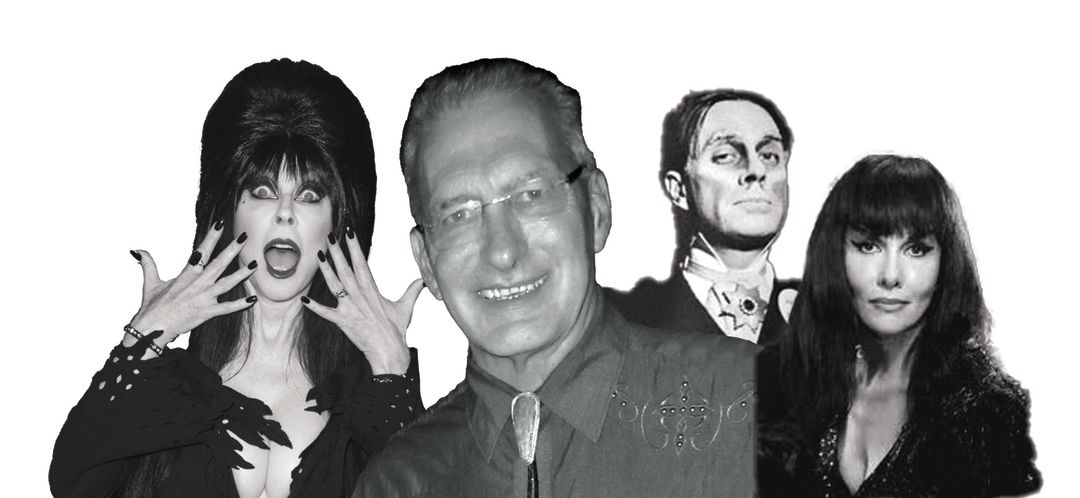
From left: Elvira, Joe Bob briggs, John Zacherle, Moona Lisa
Elvira From 1981 to 1986, Cassandra Peterson wished all of Los Angeles “unpleasant dreams” as the host of Movie Macabre with Elvira, Mistress of the Dark. The show featured a lineup of B movies like The Incredible 2 Headed Transplant and The Navy vs. the Night Monsters, which Elvira would inject with anarchic Valley girl commentary; her punky beehive hairdo and low-cut black dress remain instantly recognizable.
Joe Bob Briggs Tuning in to John Bloom’s terse redneck persona was a regular ritual for many ’80s and ’90s kids, first on the Movie Channel’s Joe Bob’s Drive-In and then on TNT’s MonsterVision, which featured classic and schlocky horror films, peppered with faux-highbrow critiques from Briggs. Before each movie, Briggs would brace audiences for the gore to come with his “Drive-In Totals,” which included a head (roll) count.
John Zacherle John Zacherle’s Shock Theater, which aired on Philadelphia’s WCAU-TV from 1957 to 1958 (making it a real Vampira and Tarantula contemporary), featured more worldbuilding than most. In it, he played a ghoul named Roland who lived in a crypt with his wife, “My Dear,” and son, Gasport. They rarely appeared on the show, but Roland would regularly drive stakes through My Dear’s heart.
Moona Lisa Though hardly any footage remains from Moona Lisa’s time hosting Science Fiction Theater, which aired on KOGO-TV in San Diego from 1963 to 1971, in one surviving clip she's introduced as “San Diego’s own Mistress of the Dark”—ball’s in your court, Elvira. The program, which ran Saturday afternoons, starred Lisa Clark as Moona Lisa, who hosted both horror and science fiction films and became a long-haired sex symbol. —By Michelle Harris



